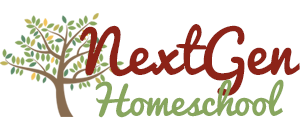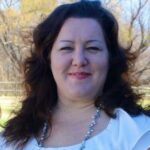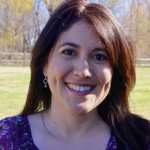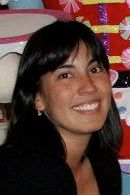Welcome to “Ask a NextGen Homeschooler…“ It’s your turn to ask the authors of NextGen Homeschool — four formerly homeschooled moms who are now homeschooling our children — to weigh in on your homeschooling questions. From the practical to the personal, all questions are welcome — whether you’re a current homeschooler or just homeschooling curious!
The question of curriculum is such a hot topic, we decided to update this post to reflect our opinions on curriculum options today. Plus, it’s still one of the first questions we receive about homeschooling:
How do you make homeschool curriculum choices? What did your parents use when you were the student, and how did your prior experience being homeschooled influence your curriculum choices today?
We realize that curriculum is a very personal choice — personal to both the teacher and the students. So our intent in answering this question is not to necessarily provide specific curriculum advice. Instead, we want to give you a peek inside our world: Find out what we experienced as homeschooled students, what framed our points of view on curriculum, how we make curriculum choices, and what we’ve chosen for our families to use at this point in time.
NextGen Homeschool Author Rosanna Ward
Was homeschooled since 8th grade
Began homeschooling in 2005
Two homeschool graduate daughters & two sons (ages 7 & 2)
When my family began homeschooling us, I don’t believe there were very many options available yet as far as curriculum went. We used the Alpha Omega workbooks — I think because my parents could buy them a few at a time — and picked up free textbooks through a local book drop in the basement of a Tulsa public school, where we could pick up free books the schools no longer used. We also used Bob Jones curriculum for science, and my dad used his own books (which were college textbooks) for German, history, philosophy, and theology.
I enjoyed the workbooks because I felt I had accomplished a goal every time I finished a book or a whole year of books. My parents never seemed concerned about gaps in our overall education or keeping track of credits. I don’t remember having a transcript. I took the ACT college entrance exam when I was 16 and started at ORU (Oral Roberts University) that fall.
The world of homeschool curriculum has changed drastically since the 80s. Now the choices are so diverse, they can make your head spin.
The first couple of years into homeschooling my own children, I was like a curriculum addict, trying everything. There is a curriculum for every learning type and trying to match this with each child was my goal. I felt workbooks wouldn’t allow me to be as involved with my girls’ learning as I wanted to be, so I went with more of an eclectic unit study approach.
My eldest daughter is very hands-on, so the unit studies worked for her — and I liked them because I got to be more involved. I also enjoyed the fact that I could center them around history, my favorite subject. However, when I look back, I think my second daughter would have been better served with a more visual and independent workbook style.
Now both daughters have graduated, so I have essentially started over again with my son, who is 8 years old. I see that he will do well with a workbook-style curriculum, which will work great for this time in my life when I also have a toddler running around.
With my older girls, we used and liked these curriculum options: Shurley English, Jensen’s Format Writing, Saxon Math, Diana Waring’s History Alive, Drive Thru History, Joy Hakim’s “The History of US,” and Apologia Science. I also use E.D. Hirsch’s “What Your _th Grader Needs to Know” (one book per grade) series and Robin Sampson’s “What Your Child Needs to Know When” books.
This past year with Joel, I think pretty much everything was new! I used Rocket Math and Life of Fred: Apples (his first Life of Fred book) for math, First Language Lessons for the Well-Trained Mind and Spelling Power for language arts, The Story of the World: Volume 1, Ancient History for history,
and manipulatives for science (right now, it’s an electronics snap kit).
NEW FOR FALL: I have chosen a few new curriculum options for the upcoming school year. I’ll be using Firmly Planted from Heidi St. John and Rachael Carman’s HisSunflower.com character traits for Bible lessons instead of BJU Bible like I had planned. I will continue to use Life of Fred and Rocket Math, but I am thinking of using some Saxon later in the year. I will start using Shurley English, which I have used in the past with my two now-graduate daughters. We’ll move on to Story of the World, Volume 2 and add Diana Waring Presents: Romans, Reformers and Revolutionaries. I also plan to add some music instruction using Freddie the Frog Books and Maestro Classics.
It is still hard narrowing down my choices. I have to continually drag myself away from the bookshelves and call it good.
Purchasing the curriculum can also be a daunting task, especially for larger families. However, I’ve found lots of resources to help with that. We have a once-a-month free book drop here where I live in Oklahoma, and I shop at a used consignment homeschool store called Bibliomania and a large Christian bookstore that sells a wide variety of homeschool curriculum. We also pick up used books online and at the local Goodwill stores. Prices range from free to however much you want to spend. I usually buy my main books at Bibliomania — supplementing what they don’t have there with new purchases and free resources I’ve picked up.
NextGen Homeschool Editor Renée Gotcher
Was homeschooled in 11-12th grade
Began homeschooling in 2010
Three daughters ages 12, 10 and 5
When my mom started homeschooling us, I only had two years left of high school. And for all intents and purposes, I was pretty much done with core requirements for college: All advanced math (up to calculus), required language (two years of Spanish), and AP classes in English, history and government. Wrapping up those few credits that remained didn’t require much in the way of formal curriculum.
However, my mom didn’t take it easy on me and kept up all my core subjects. For example, even though I had completed high school math, she purchased a Saxon Advanced Math textbook for me to work on — because we can all use more math, right? Even though I had the required language credits in Spanish, she (being a French minor in college) started teaching me French as well. At the same time, she also gave me great in-depth projects to work on that I would not have been able to do in traditional school, such as creating an entire newspaper from scratch (pre-desktop-publishing days) and editing the writing projects she was working on. If I had to give it a label under today’s homeschooling standards, I’d say it was an eclectic approach.
Her curriculum choices worked for me because I was able to work the way I was already used to — independently — and work at my own (speedy) pace without instruction or lectures. The only lectures my mom gave me those two years while I was still home were about things like biblical character qualities and being spiritually prepared for my adult life. I didn’t always appreciate it at the time, but I’m extremely grateful for those lessons now because I can see the Godly influence my mom was able to have on me when I needed it.
I do wish we’d done more “hands-on” activities together, which is something I try to keep in mind when working with my girls. Not because I had need to learn anything more to be ready for college, but because I think there are a lot of skills and gifts my mom possessed that I would have loved to have passed on to me — authentic Mexican cooking, for example! She did let me edit one of her big freelance writing projects, though, and at the time I didn’t consider that part of our homeschooling. However, I can see now that the back and forth between her and I on that project was probably one of the most important influences on my future career as a journalist and editor.
When I finally decided I was ready to homeschool my three girls, the curriculum scene had drastically changed. I recognized a few familiar names in the Christian publishing industry, but there were so many more — and so many educational philosophy terms I’d never heard of before (classical, directed learning, eclectic, unschooling, literature-based, and so on). I was really overwhelmed, so I started interviewing every mom in my local homeschool group with children the same ages as mine, to see if someone was already using something that made sense to me. Better to ask a veteran who’s had experience with these methods and curriculum options than to try and digest all that was out there on my own.
Fast-forward three years, and I’ve tangoed with quite a few different curriculum choices. If you haven’t followed my journey, here is the short story…
- First Year: My Father’s World and why it didn’t work for us
- Second Year: Why I chose to try Heart of Wisdom & Charlotte Mason method
- Third Year: How I started with Heart of Dakota, ended up with Paths of Exploration
Yes, you read that right: We started our “official” school year this past fall with the highly regarded Heart of Dakota — in hopes of finding something more flexible, more “laid out” (ready to go) and more easily customizable to my three daughters’ ability levels, while also being faith-based and unit-study driven like Heart of Wisdom. But it just didn’t fit our family in daily practice.
So I revisited a curriculum that I had been interested in for some time, Paths of Exploration from the Trail Guide to Learning series. It takes a unit-study approach, with a biblical worldview, and integrates every subject except math into the unit study. One thing that had always appealed to me about POE was the fact that you can download one unit at a time online, rather than purchasing a whole year’s curriculum at once. Perfect for tentative buyers like me who want to see if something is going to work before making a full-fledged investment! I also loved the grade-specific student notebooks: So while we are covering the same topics as a family, the girls have accompanying work that is customized for their abilities at their grade level.
We are continuing to finish the Paths of Exploration series this summer, and the girls and I are absolutely loving it! For more details about our switch, read my post, “Oops, I did it again… Changing curriculum again, and again.”
When it came to math, we had discovered early on in our homeschooling journey that Math-U-See worked fabulously for all three girls. We started using it exclusively in our second year and haven’t looked back. It’s been a real blessing to have a curriculum that works for all three girls so efficiently.
NEW FOR FALL: Last year I tried three different reading programs with my youngest daughter Elise. Although she was able to follow along for a time with all of them, we ran into two problems. First she became disinterested in a matter of minutes, and it was always a struggle to finish and keep her engaged. Then she would forget things we learned a few lessons ago, so we were constantly going back — and that frustrated her even more.
I did some more research on the learning styles of children and discovered that Elise is a kinesthetic (movement) and auditory (listening) learner all the way. While attending the Teach Them Diligently Convention in June, I attended a workshop with Denise Eide from The Logic of English and learned how to use their Foundations curriculum to work with her dominant learning styles. On Denise’s recommendation, I’ll also be teaching Elise to write in cursive, which she was begging me to do all year anyway! Stay tuned for an upcoming review as Elise and I begin working on it together this month.
One of the things I love about homeschooling most is that all curriculum decisions are up to you! Unlike a traditional school, you don’t have to be stuck with any curriculum or teaching approach that’s not working for your children. You don’t have to cross your fingers and hope for a better teacher next year. You can make adjustments whenever they are necessary, and you’ve got more than enough tools at your disposal to create the ideal homeschool environment for your family.
NextGen Homeschool Author Cristina Eklund
Was homeschooled since the 6th grade
Began homeschooling in 2010
A son (7) and daughter (4)
So curriculum… this can be super scary for some, I’ve learned, but I have absolutely enjoyed choosing curriculum. I think this is because before I ever looked at any, I had a clear idea of the direction I wanted to take in educating my children after reading many books and blogs from recommended authors. That advance research helped me narrow down the possibilities from thousands of options — and I didn’t even go to one of those big homeschool conventions.
Choosing curriculum has so much to do with your faith (what you believe is important to impart to your children), your season of life (one kid, two kids, or eight kids like my mom) and your own personality in general (whether you like to read teachers manuals to give you security or you are more creative and like to be a part of the entire learning process).
That said, I have to admit that I am starting my journey as a homeschool mom veering far from the ways I was homeschooled. I can see in retrospect that my mom’s approach as a mother of eight probably had a lot to do with survival. We used Alpha Omega packets for science and history and regular school textbook for math and English. Being an older student, I generally was doing my work independently, which wasn’t too hard to do with these basic tools.
Though I was artistic at heart, we never made a point to read any great literary works (just some biographies), observe nature in its natural setting or study any art history — which I don’t begrudge because I have found my way to these things as an adult. We covered the basics, and I was also able to stay clear of traditional school socialization pitfalls (see our previous post on homeschool socialization).
Because of my past experience, I didn’t gravitate to the homeschool books I remember seeing on the bookshelf as a kid: Instead, the first book I picked up was “For the Children’s Sake” by Susan Schaeffer Macaulay, and I am so glad I did. I found my eyes opened to an even more exciting reason to educate my children at home rather than the usual “fear of the government” and “bad kids” motivators. I saw an opportunity to open doors for my children to a true love for learning and beauty in all aspects of life through the educational philosophies of Charlotte Mason.
This was a totally different way of seeing education that I was used to. Not just reading, writing and arithmetic, though those things will always be a part of education. Charlotte Mason said “Education is a discipline, education is an atmosphere and education is a life.” This point of view is seeing your children as born people who — when nurtured on a feast of noble ideas through “living” books, picture study, nature study and all the things we usually deem as “extras” — are better able to develop their own ideas utilizing all that is at their disposal: God’s world in nature, art, literature, history, music and, of course, God’s written Word.
Some websites I enjoy and resources for living books lists:
- Simply Charlotte Mason: Free ebooks about Charlotte Mason Education.
- Ambleside Online: I don’t follow scheduling exactly, I just use the resource lists.
- Moments with Motherculture: Encouraging and inspiring author, her books are a “must” read.
Other Resources I found helpful and enriching:
- Five in a Row: I don’t do the actual reading Five in a Row, but I use the study guides when we read the books to cover a particular subject.
- Practical Pages: Pulls together Charlotte Mason and notebooking.
- Doorposts: For habit and character training.
- Explode the Code: Phonics
- Handwriting Without Tears: Introduction to handwriting.
- Montessori Letters Montessori-Small-Movable-Alphabets-Box: For spelling practice.
NEW FOR FALL: These are specific curriculum sources that I’ve chose for the upcoming year to work with my 2nd grader Elijah and preschool/kindergartener Arielle:
- Queen Homeschool: Language for Little Ones and Living Math Series. These are workbooks without being dumbed down — still following Charlotte’s methods (like including poetry, picture study and living stories). I plan to use them at different levels for both children.
- Life of Fred for both (different books)
- Science: The LBC Guide to Astronomy & Discovering Nature series: Our Animal Friends (also from Queen Homeschool)
- History: My Father’s World 2nd grade Adventures in U.S. History (including readers and read-alouds from Beautiful Feet and a living books reading list). For kindergarten: Christian Liberty Press History for Little Pilgrims (including read-alouds and living books curriculum).
- Happy Phonics & Handwriting Without Tears for Kindergarten Language Arts
It is my hope that my kids will become truly educated individuals in every sense of the word, to be able to discourse with every type of person, to see every day as an opportunity to enjoy what God has created, to see beauty in words and art and life, and to put God first above all else in all of life’s circumstances.
NextGen Homeschool Author Elizabeth Thomas
Was homeschooled from K-12th
Began homeschooling in 2009
Five daughters ages 13, 12, 10, 4 and 4 months old
As a student, I used Alpha Omega books all through grade school, Saxon Math and Bob Jones through junior high and high school. I would say Alpha Omega was pretty easy, but it’s not as hands-on with the parents. I felt like I was stretched to be my own teacher in a lot of areas, because the curriculum required less parent involvement. This is great if you are self-motivated, but I was not and I think I would have benefited from a lot more supervision.
Today, I do use a lot of Bob Jones because I know it (same with Saxon Math), and the rest I mix and match depending on each child’s learning styles. I also try to match my teaching styles with their learning style… all four of my daughters are totally different, and that makes my job fun and interesting! Stormie (my 13-year-old) does better with A Beka books. I discovered this year that Rod and Staff seems to be great for Faith (who’s 10) — she needs less color and pictures in her books so that she can focus, and she also needs to repeat things over and over. I love Shurley English and all of my girls love it too! Mainly, I like to use whatever works with each child.
I’ve had to make a lot of changes this year. I’ve had a hard time teaching Faith math, and Math-U-See was just what she needed. In fact Rachael, my 12-year-old, started to like Math-U-See as well, so I’ve switched her too. Stormie loves Teaching Textbooks for math, but I do not feel that it will really prepare her for the ACT. So after she does the Teaching Textbooks Algebra 1 over the summer, I’m going to start her in Saxon’s Algebra 1 and use it for Algebra 2 as well. I really think it’s important for her scores to be high on the ACT and not as important for her to graduate early.
I’ve switched to Apologia Science, because Faith loves it! Stormie dislikes science (finds it to be “dull”) and that did not change with Apologia, so I think she’s just not into it. We are doing The Story of the World: Volume 1, Ancient History and some Rocket Math with my sister Rosanna as well — we love both!
We also put our eldest three daughters in piano lessons, and Faith is teaching 4-year-old Cadence to play. Cadence is playing Twinkle, Twinkle, Little Star on the piano — it’s so cute! I am super proud when they teach each other, because that means they really get it! Those are some of the best homeschooling moments for me.
I also keep a list of what they should be learning (core skills) each year, so that I can check off what they know and keep track of what they need to work on. I use a lot of additional books to supplement. I have used Goodwill, Bibliomania, Craigslist, thrift stores, Amazon.com, and the free books trade at a local church. Oklahoma is such a big homeschooling state that finding used books can be pretty easy. For example, I got one of our Saxon Math books at Goodwill for $1 and picked up the accompanying answer keys for free at the book trade. If you’re resourceful, you can assemble a very complete curriculum for your children without spending thousands.
This post was originally published on March 25, 2013 and was updated with new information on July 5, 2013.
How did you decide what curriculum you would use for your homeschool, and has it changed over the years? Did any prior experience with homeschooling have an impact on your decisions? What’s new in your curriculum plan for the 2013-2014 school year?


 NextGen Homeschool Author
NextGen Homeschool Author 


Very interesting read! I was homeschooled from fourth grade through high school. I began homeschooling my children in….well, that’s hard to say. We are more of the unschooling type, especially in the lower grades. But, I’d say 2006.
We’ve actually bought precious little curriculum compared to some. We’ve been writing our own the last few years and have been loving that process. The kids really enjoy it as well.
You can check out some of those resources on our website: https://theprovisionroom.com/books-resources/
By the way, I’m visiting via the Hearts For Home Blog Hop!
Wow this was a treat to see so many different perspectivies on curriculum all in one neat place. Thanks for putting this together!
Glad it’s helpful for you, Nita! That’s what we were hoping – to show diversity in our approaches & what we use, and how it all still works for each of us!
Renée
Hello! I have been looking at home schooling cirriculum for my daughter as a supplement to public school. I would consider home schooling alone but next year she will be going to a public school that offers a Chinese immersion program. For me, I feel that learning a second language for my daughter is so benifical but something I cannot do for her at home. I don’t have a lot of time to pick and choose my own cirriculum and need something that is already “set-up” that I can guide her through. She enjoys learning and often is the one asking questions about different subjects with no prompting and that’s why I feel she needs a supplement. I found a few programs available for purchase, one being My School Room (www.myschoolroom.net). I am wondering if anyone knows anything about this or has any reviews about it. OR is there is a program like it that they like better. It costs $200 but I am completely willing to pay for it if it is something that will help my child! Thanks!
Hi Kimbra,
I don’t have any experience with My School Room, but I do know that there are many “out of the box” curriculum options out there that are wonderful. They come complete with lesson plans, assignments, books, and more. In our home, we use a unit-study based curriculum called “Trail Guide to Learning,” and my girls love it. Everything we need for all subjects except math is included. I use Cathy Duffy Homeschooling Curriculum reviews whenever I want to research a company, and it’s very helpful. Hope that helps!
Renée
Kimbra, I know this is a few months past due. However, I am the creator of My Schoolroom and have added some significant additions since your post in late November. Namely, My Schoolroom now has higher quality books, shareable exams and flashcards, and now is linked with Librivox to bring over 400 very high quality audio recordings of the classics. I am also working on mobile versions so the books can be read easier instead of printing them out.
Anyways, if you haven’t picked something yet I would love to give you a free license. Please contact me separately through the website. Also I would love any honest reviews you have and to know what works for your family. Thanks.